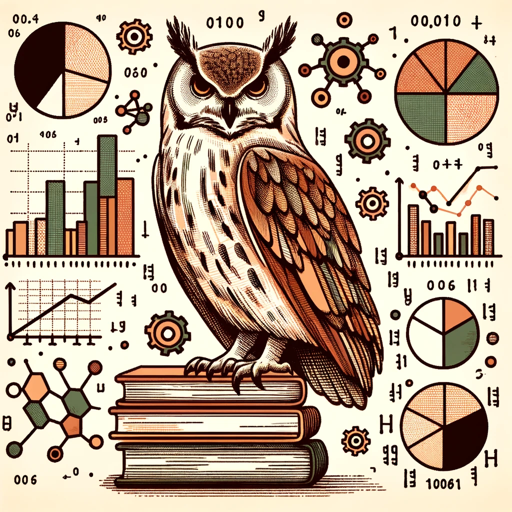Data Science-data science insights and analysis.
AI-Powered Data Science Insights
Analyze this data set for trends.
Suggest a visualization for this data.
Interpret these statistical results.
Help me understand this complex data.
Related Tools
Load More
Data Scientist and Analyst Assistant
Advanced assistant for data science, machine learning, and ethical AI guidance (Version 2.0)

Data Science Consultant
Expert data science consultant and tutor, guiding on models, techniques, and code.

Data Science Owl
Select a demo dataset or upload a new one

Data Engineering and Data Analysis
Expert in data analysis, insights, and ETL software recommendations.

Data Science Interview Mate
A serious interviewer

Data Science Class for Economic and Social Issues
Create Course Content - TAMU
20.0 / 5 (200 votes)
Introduction to Data Science
Data Science is a multidisciplinary field that combines statistical analysis, machine learning, data visualization, and domain expertise to extract meaningful insights from data. It involves the collection, processing, analysis, and interpretation of large volumes of data to support decision-making processes. The purpose of Data Science is to uncover patterns, predict trends, and derive actionable insights that can be used to solve complex problems. For example, in a retail scenario, Data Science can analyze customer purchasing patterns to optimize inventory management and personalize marketing strategies.

Main Functions of Data Science
Data Collection and Cleaning
Example
Web scraping and cleaning of social media data for sentiment analysis.
Scenario
A company wants to analyze public sentiment about its new product. Data scientists collect tweets mentioning the product, clean the data by removing duplicates and irrelevant information, and prepare it for analysis.
Exploratory Data Analysis (EDA)
Example
Using visualizations to identify trends and outliers in sales data.
Scenario
An e-commerce platform examines its sales data to understand seasonal trends. EDA helps to visualize spikes during holiday seasons and identify outlier days with unusually high or low sales, guiding marketing and inventory decisions.
Predictive Modeling
Example
Developing a machine learning model to predict customer churn.
Scenario
A telecommunications company uses historical customer data to build a predictive model that identifies which customers are likely to switch to a competitor. This model helps the company to proactively address customer concerns and improve retention strategies.
Ideal Users of Data Science Services
Businesses and Enterprises
Companies of all sizes use Data Science to enhance decision-making, optimize operations, and improve customer experiences. For instance, businesses leverage data-driven insights for targeted marketing, fraud detection, and operational efficiency.
Healthcare Professionals
Healthcare providers and researchers benefit from Data Science in diagnosing diseases, predicting patient outcomes, and personalizing treatment plans. For example, predictive models can analyze patient data to forecast disease outbreaks and allocate resources efficiently.

How to Use Data Science
Step 1
Visit aichatonline.org for a free trial without login, also no need for ChatGPT Plus.
Step 2
Identify the type of data or problem you need help with, such as data analysis, visualization, or interpretation.
Step 3
Prepare your data. Ensure it is clean, properly formatted, and ready for analysis. This may involve handling missing values, normalizing data, or organizing it into a suitable structure.
Step 4
Choose the appropriate analytical tools or techniques based on your data and objectives. This might include statistical analysis, machine learning, or data visualization.
Step 5
Implement and review your analysis, ensuring the results are accurate and actionable. Iterate as necessary to refine insights or adjust methods.
Try other advanced and practical GPTs
Italian
Enhance your Italian with AI precision

Cartoonize Family Photo
Turn your photos into charming cartoons with AI

Sentient
Empower Your Ideas with AI

SEO Generator Auto
AI-powered SEO for Redbubble

Blog Enhancer
Enhance Your Blog with AI Power

MiddleYears-GPT(IB MYP)
AI-driven assistance for MYP educators

ArchitectGPT
AI-powered custom home design

Design Digital Art For POD
Transform images into digital art effortlessly with AI.
The Melanin Canvas
AI-powered illustrations for African American subjects.

Organizational Architect
Optimize your workforce with AI

THOMAS | Avatar Utópico de Social Media
AI-Powered Social Media Engagement

Red Bubble SEO Generator
AI-powered SEO for Redbubble Listings

- Data Analysis
- Visualization
- Exploration
- Modeling
- Prediction
Q&A About Data Science
What types of data can I analyze with Data Science?
You can analyze various types of data including numerical, categorical, textual, and time-series data. Data Science can handle structured and unstructured data from diverse sources such as databases, spreadsheets, and web services.
How can Data Science help in decision making?
Data Science assists in decision making by providing data-driven insights, identifying trends, forecasting outcomes, and offering predictive analytics. It transforms raw data into meaningful information to guide strategic decisions.
What are common techniques used in Data Science?
Common techniques in Data Science include regression analysis, classification, clustering, time series analysis, and data visualization. These methods help in understanding patterns, making predictions, and drawing insights from data.
Can Data Science handle big data?
Yes, Data Science can handle big data through advanced tools and frameworks that support large-scale data processing, such as Hadoop, Spark, and distributed databases. It enables the analysis of vast amounts of data efficiently.
What are the prerequisites for using Data Science?
The prerequisites for using Data Science include having access to relevant data, understanding the problem domain, and familiarity with data analysis tools and techniques. Basic knowledge of programming and statistics is also beneficial.